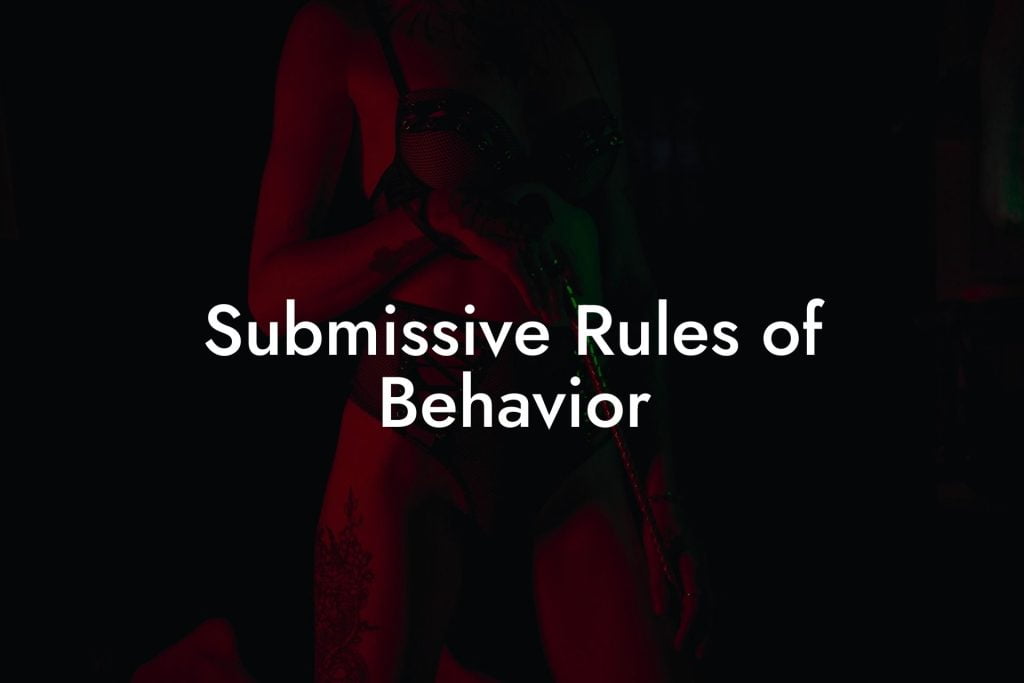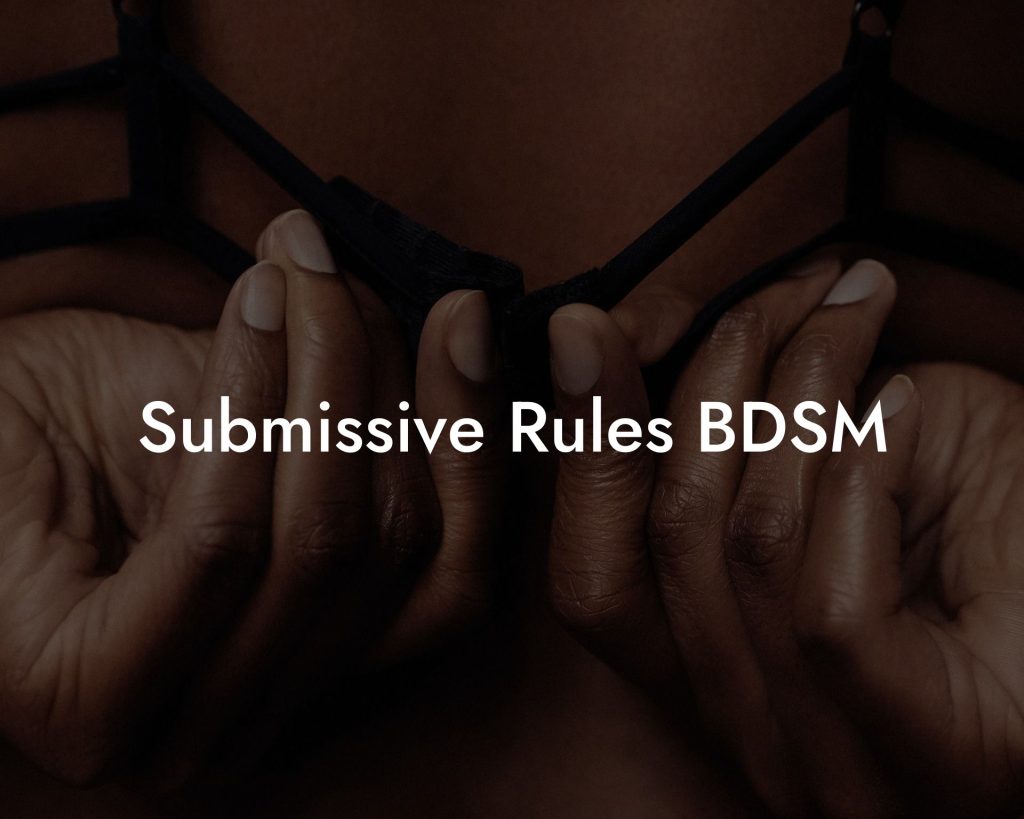Setting boundaries and establishing clear limits are essential in any BDSM relationship or exploration. Whether you're a seasoned practitioner or a curious beginner, understanding and respecting personal limits is crucial for a safe and fulfilling experience. In this blog post, we present the BDSM Limits Worksheet, a valuable tool designed to help you navigate the intricate world of BDSM with confidence and respect. Get ready to delve into the realms of consent, communication, and self-reflection as we guide you towards a better understanding of your desires, limits, and boundaries.
In any BDSM relationship, consent is the cornerstone of trust and respect. It’s more than just saying “yes” or “no”—it’s about openly communicating your desires, limits, and expectations. But trust doesn’t end with a conversation—it’s built through ongoing, clear agreements. That’s where our Dominant & Submissive BDSM Contract Pack comes in. Find out more →
BDSM, an acronym for Bondage, Discipline, Dominance, Submission, Sadism, and Masochism, encompasses a wide range of activities, practices, and dynamics. From light spanking to intricate role play, the world of BDSM offers endless possibilities for exploration and pleasure. However, before embarking on any BDSM experience, it is crucial to establish boundaries and negotiate limits with your partner(s). Here are the key elements to consider:
Consent
Consent is the cornerstone of any healthy and consensual BDSM dynamic. It is essential to obtain explicit, informed, and ongoing consent from all parties involved. Our BDSM Limits Worksheet prompts you to reflect on your comfort levels and establish clear consent guidelines, ensuring a safe and enjoyable experience for everyone involved.
Communication
Open and honest communication is the key to a successful BDSM relationship. The BDSM Limits Worksheet provides space for you to discuss desires, expectations, and limits with your partner(s). From hard limits (activities you absolutely do not want to engage in) to soft limits (activities you are unsure about), effective communication allows for trust, understanding, and the mutual exploration of boundaries.
Self-Reflection
Understanding your own desires and limits is essential before engaging in BDSM activities. The BDSM Limits Worksheet encourages self-reflection, guiding you to consider various aspects such as your physical and emotional boundaries, past experiences, interests, and triggers. By reflecting on these factors, you can better communicate your needs to your partner(s) and ensure a tailored and fulfilling BDSM experience.
Looking for the best BDSM & Kink OnlyFans content creators? Here is a list of of our favourites that you will love:
-
- Best BDSM & Fetish OnlyFans - Molly✨ >> Link
- Best BBW & Huge Ass OnlyFans - Naughty Hanna Zimmer 💜🎀 >> Link
- Best Sexy Gaming Nerd OnlyFans - 🎮 Gracy EstuSWEET 🎮 >> Link
- Best Fetish & Kink Messaging OnlyFans - 💫Lola La Fleur 💫 >> Link
- Best Girl Next Door OnlyFans - ☀️Lily ⛅ >> Link
- Best Tiny European OnlyFans - 💝 Ami Allison 💝 >> Link
- Best Cosplay OnlyFans - 🐱 Little Kitty Kate 👉👌 >> Link
- Best Little OnlyFans - 🧸 Katya 🙇♀️ Sun >> Link
- Best Sub OnlyFans - 🍌Hanna Banana🍌 >> Link
- Best Teen & Huge Tits OnlyFans - ❣️Anny❣️19 y.o. BUSTY student girl >> Link
- Best Tiny Tits OnlyFans - ⍣⭐️ Sofia Parker ⭐️⍣ >> Link
- Best Sub & Huge Boobs OnlyFans - Nika Huge Boobs >> Link
- Best Kink OnlyFans - Sofia💖 >> Link
- Best Fetish & Girl Next Door OnlyFans - Hillary is Wet 💦 >> Link
- Best Dirty Latina OnlyFans - Paula Flores 😈 >> Link
Not quite what you are looking for? View the full list →
Frequently Asked Questions
What is a BDSM contract?
A BDSM contract is a written agreement between the participants in a BDSM relationship or scene. It outlines the responsibilities, limits, and expectations of all parties involved. Although not legally binding, it serves as a symbolic commitment to consent and trust within the relationship.
Why would someone engage in a BDSM power dynamic?
Individuals may engage in BDSM power dynamics for a variety of reasons, including exploring their sexuality, experiencing intense physical sensations, fostering deep psychological connections, or enjoying the creative freedom and playfulness the activities can provide.
How important is consent in BDSM?
Consent is absolutely fundamental in BDSM. It ensures that all activities are safe, sane, and consensual. Without clear and enthusiastic consent from every participant, BDSM activities should not proceed.
What does "safe, sane, and consensual" mean?
"Safe, sane, and consensual" is a cornerstone phrase within the BDSM community that highlights the importance of safety, mental stability, and consent in all BDSM activities. It underscores the necessity of clear boundaries and mutual agreement for all practices involved.
What are safe words, and how are they used?
Safe words are pre-agreed-upon signals used to communicate during BDSM activities. They allow participants to withdraw consent or adjust activity intensity. A common system is the traffic light system where "red" means stop, "yellow" means slow down or check in, and "green" means everything is okay.
What is aftercare, and why is it important?
Aftercare refers to the attention and care given to participants after a BDSM scene to ensure emotional and physical well-being. It may include activities such as cuddling, debriefing the scene, or addressing any physical pain. It's a crucial step in fostering trust and care between partners.
How do people negotiate a BDSM scene?
Negotiation in BDSM involves discussing and agreeing upon activities, roles, limits, safe words, and aftercare before a scene occurs. It's done to ensure the mutual comfort and consent of all parties involved, and can greatly enhance the experience.
Can BDSM activities involve romance and love?
Absolutely, BDSM activities can and often do involve romantic relationships and love. The deep trust and communication involved in BDSM can enhance intimacy between partners.
Is it possible to have a BDSM relationship without sex?
Yes, not all BDSM relationships or activities involve sex. BDSM can be more about power dynamics, sensations, or psychological play rather than sexual gratification.
What does "limits" mean in the context of BDSM?
"Limits" refer to the boundaries set by individuals in BDSM. These can be actions or behaviors that a person is not comfortable with, either for personal, emotional, or safety reasons. Limits are categorized as soft limits (things you might be willing to try under certain circumstances) or hard limits (things that are non-negotiable and must not be crossed).
How should someone prepare for a first BDSM experience?
Preparation for a first BDSM experience should include research, self-reflection on limits and desires, discussion and negotiation with potential partners, and arranging a safe space for the activities. It is advisable to start with less intense activities to build trust and understanding.
Are BDSM contracts legally binding?
No, BDSM contracts are not legally binding documents. They are typically used as personal agreements that outline the expectations and commitments of those involved in a BDSM dynamic.
What if I change my mind during a scene?
If you change your mind during a scene, it's important to communicate this immediately to your partner, typically by using the predetermined safe word or signal. All participants should respect this without hesitation.
How do trust and communication play a role in BDSM?
Trust and communication are the bedrock of BDSM interactions. They create a safe environment where participants can express their desires and limits. Effective communication ensures that scenes are consensual and enjoyable, while trust allows for vulnerability and the relinquishment or acceptance of control.
Is it necessary to have a BDSM contract?
While not necessary, a BDSM contract can be a useful tool for clearly defining the terms of a BDSM relationship or scene, especially for those who want to establish clear rules and responsibilities.
How can someone learn more about BDSM safety?
One can learn more about BDSM safety by engaging with the BDSM community, attending workshops, reading literature on the subject, connecting with experienced practitioners, and seeking online resources dedicated to safe BDSM practices.
Can BDSM include activities that are not physically painful?
Certainly, BDSM is not synonymous with pain. It encompasses a wide range of activities, including role-playing, restraint, sensory deprivation, or psychological play, many of which do not involve any physical pain.
How can people in a BDSM relationship handle misunderstandings or mistakes?
Communication is key in handling misunderstandings or mistakes in a BDSM relationship. It's important to discuss what happened, acknowledge feelings, learn from the experience, and set new guidelines to prevent future issues. An understanding and compassionate approach is crucial.
Is it okay to have multiple partners in a BDSM context?
Having multiple partners in a BDSM context is a personal decision and is okay as long as there is clear, informed consent from all parties involved and everyone practices safe and responsible BDSM.
Are there different roles people can take in a BDSM dynamic?
Yes, there are many roles one can take in BDSM, such as Dominant, submissive, Switch (someone who can take on both Dominant and submissive roles), or specific roles within certain scenes like Master, Mistress, Slave, Pet, and others. Each role has its own expectations and behaviors.
How vital is privacy and discretion in BDSM?
Privacy and discretion are extremely important in BDSM due to the personal nature of the activities and the potential for social stigma. It also protects the identities and emotional well-being of the participants.
[Include links to the Ultimate BDSM Contract Pack, other guides, and the fetish shop.]













